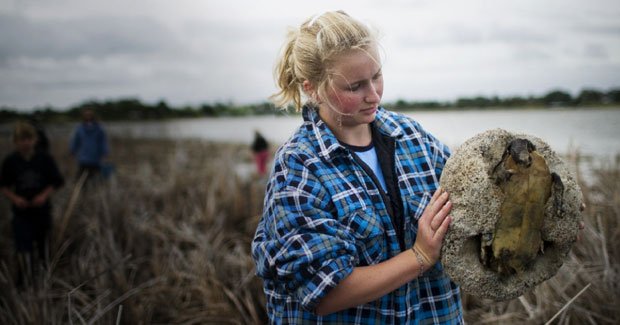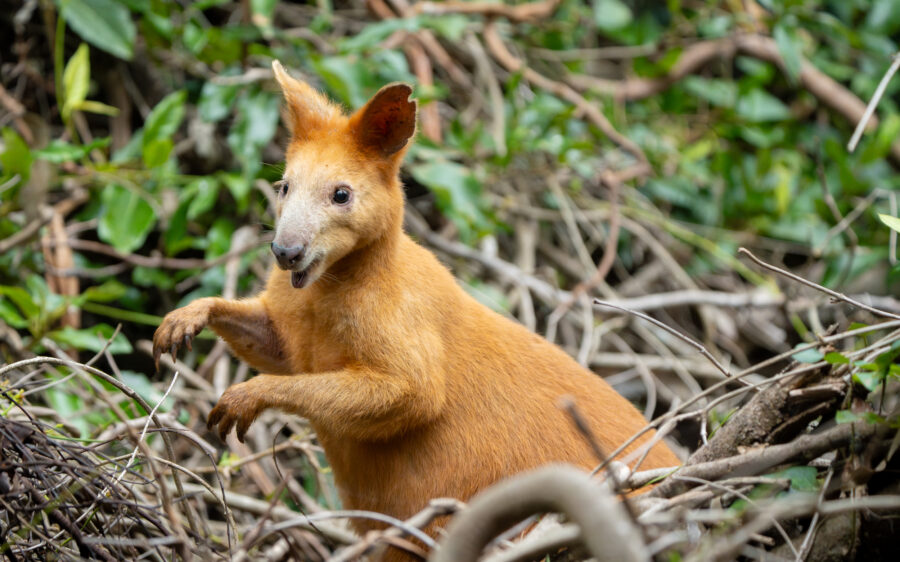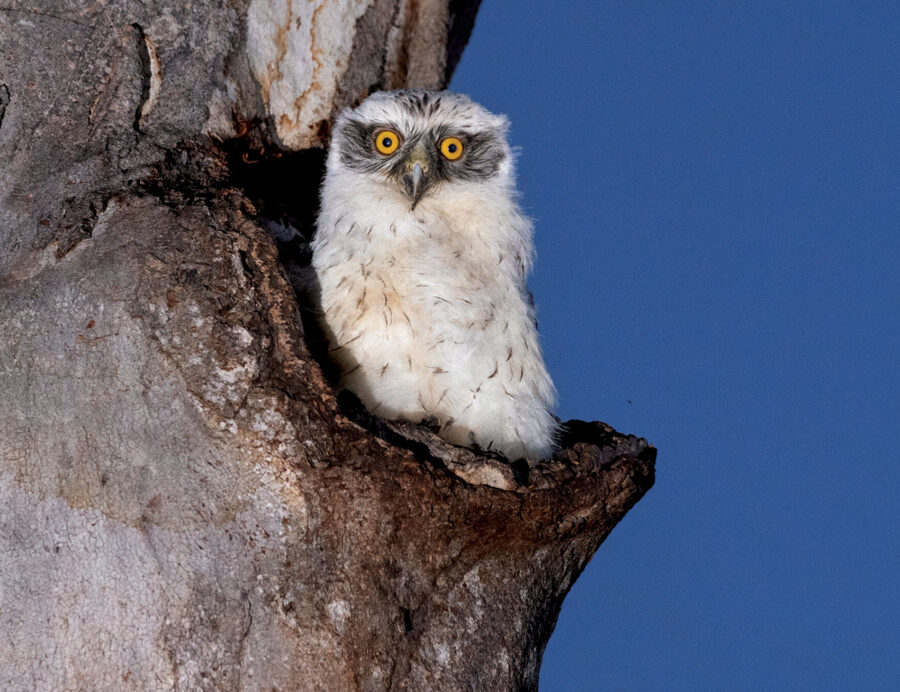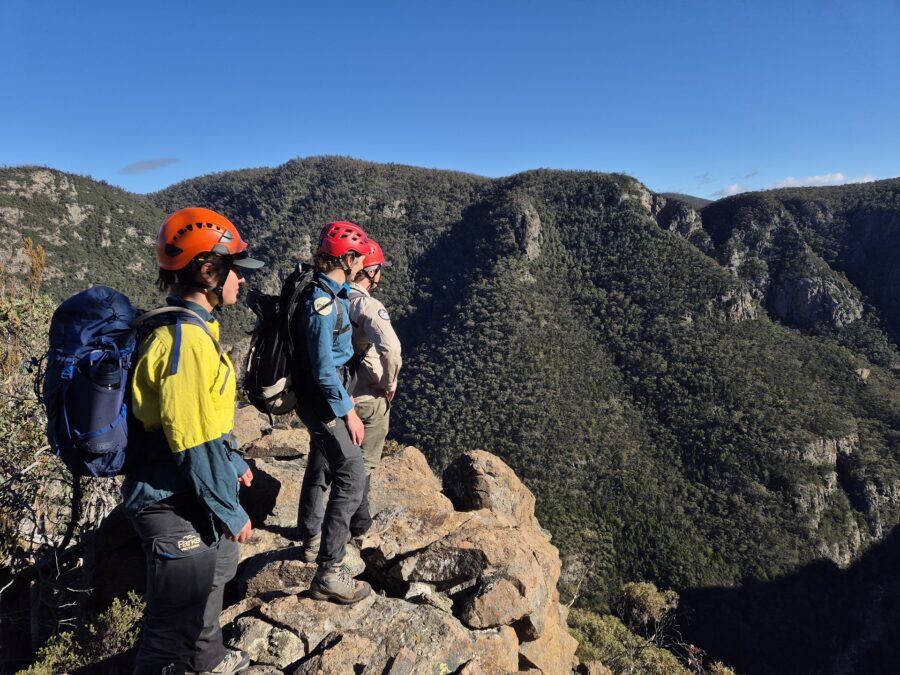The Murray’s crusaders

THROUGH A JUNGLE OF reeds left for dead by a retreating Murray River, Chris Jackson’s team fans out with plastic buckets and sharp eyes for their weekly rescue mission. Success comes quickly. “We’ve got a turtle!” calls one of Chris’s pint-sized helpers, a Year 2 kid from Milang, on the western shore of nearby Lake Alexandrina, South Australia.
“Is it alive?” she shouts back as she squelches through the mud to take a look. As it turns out, the turtle is still kicking; but only just. Like the dead fish and empty mussel shells we’ve been stepping over, long- and short-necked turtles are losing the battle for survival in the gasping lower reaches of what was once Australia’s greatest waterway.
As salt levels rise and the river dries, tube worms have travelled upstream, building their homes on the native turtles – and just about anything else they can find. Scattered around the rushes are a handful of shells, some with a fresh carcass still inside, their defences disabled by the weight of the rock-heavy worm colonies. The worms also colonise the sides of the shell, preventing the turtle hiding its extremities from the probing snouts and sharp teeth of predators.
“It can’t get its head back in,” says Chris, a school service officer and former policewoman who grew up in the hamlet of Clayton, on the lake’s south-western shore. “That’s when the foxes chew at their heads and the water rats gnaw their legs.”
We’re just below Lake Alexandrina, the broad expanse into which the Murray empties after its 2500 km journey from the Snowy Mountains. Historically, it kept Lake Albert topped up and swept past Goolwa and out through the Murray’s mouth. Since 2002, however, the mouth has been kept open only by constant dredging.
“We found the first couple of dead turtles about 10 days before Easter…” Chris says. “And we’ve been saving them since then!” interrupts one of the kids. This one is going to be okay. At the end of the day, after students with screwdrivers have cleaned off the worm colonies, 18 turtles have been rescued. A few days later, they’re released upriver where the water is fresher.
There have been warnings of impending disaster for the Murray–Darling Basin for more than a decade, but here near the mouth it is suddenly real and shockingly rapid. Inflows to the Murray system remain at record lows. The removal of water for last summer’s irrigation, coupled with evaporation, has seen lake levels plummet. Normally, Lake Alexandrina’s surface is 0.8 m above sea level, but by March it had dropped to 0.3 m. When we visit, it lies at nearly 0.5 m below.
The drop has been sudden, but the problem hasn’t developed overnight. Before white settlement, says Milang historian Terry Sim, the water flow had kept the Murray mouth open for about 7500 years – even in times of drought. The lakes were rarely salty, and the environment allowed turtles, brolgas, magpie geese and fish such as Murray cod and pygmy perch to flourish. “Now the river is just a delivery channel for water, that’s how people see it,” Terry says. “You’ve got to understand the mentality of the generic irrigator. Any water that goes past the pump is wasted.”
Bad habits began early: by the 1880s, Victoria and NSW were extracting so much water, the river couldn’t sustain its flow against the ocean, says Terry, who with local ecologist Dr Kerri Muller compiled the book, A Fresh History of the Lakes. This allowed salt water to move into the lakes in the early 20th century, killing freshwater plants and forcing irrigators to sink bores. And so, in the 1930s, five barrages were built to keep the fresh water from running out, and the sea from creeping in.
It seemed to work. Around the lakes, dairies, olive groves, beef cattle and vineyards prospered. Yacht-club members raced their boats between the main towns, Adelaide families spent summers by the water’s edge, kids watched pelicans skipping across the lake and thought of Mr Percival from Colin Thiele’s Storm Boy. Then, for a few weeks in 1981, for the first time on record, the Murray mouth closed, a sign of impending trouble.
TODAY IT’S HERE. Stand on the end of the jetty at Milang, on the western shore of Lake Alexandrina, and there’s only sand beneath you. At Lake Albert, joined to Alexandrina on the eastern side, the picture becomes even worse. In some places the water has retreated more than 1 km from the lake’s edge, leaving a desert of mud and sand. One of those shorelines belongs to Phil and Yvonne Giles. “For 30 years the kids from the local kindy came here and had a picnic, and Father Christmas would come in a boat, and they’d all get excited and run down to the jetty,” says Yvonne. Not any longer. Santa comes by car these days, and last year there wasn’t even water for the kids to splash in. “We used to wake up in the mornings and there’d be a pelican on the perch, and swans…there’d be a hundred ducks,” says Phil. “But there’s no birds anymore.”
Just how quickly change has come is apparent from the graphs and maps that vigneron John Pargeter pushes across the table in his office at Angas Vineyard at Langhorne Creek, a wine region on the north-western side of Alexandrina since the mid 1800s. John, who chairs the region’s wine grape growers association, established the vineyard with some mates 11 years ago. “You looked at Langhorne Creek as the most sustainable water in the State,” he says. “We saw the Murray as being bulletproof.”
As the water retreated from the lake’s edge, John had a channel dredged for his pumps. Now the water’s too salty to use, and he was forced to stop irrigating halfway through the harvest this year. For the coming summer, there’s almost nothing available from the Murray, but John is entitled to draw water from an underground aquifer he injected water into in better times. For vineyards without this water, the outlook is grim.
As bad as things are, the papers on John’s desk point to much worse to come. Two pieces of information tell the tale. One is a SA Government forecast for the lake level, now at 0.5 m below sea level (recent rain has raised it to 0.33 below sea level), dropping to about 1.2 m below by next autumn, while the other shows salinity almost doubling in the same period.
While the Federal Government has announced a pipeline will be completed within two years to bring water to the region from upstream, John says the only long-term solution is to find an alternative supply – maybe recycled water from sewage or stormwater piped from Adelaide. “It’s a great viticultural district,” John says, pointing to a potential $3 billion in wine production in the next five years. “But the water is not there.”
The reason is clear: a lack of flow down the Murray system, thanks to a combination of record drought and an historic over-allocation of the river’s water. A CSIRO report in July warned that its best estimate of weather trends showed the flow to the Murray mouth is likely to be cut by a quarter by 2030, and if climate change makes things worse, the figure could be 70 per cent.
It’s do or die for the Murray’s lower reaches. To understand why, think of it as four separate areas: the relatively fresh river upstream, the two brackish lakes, and the highly salty Coorong. In 1830, when explorer Charles Sturt travelled down the Murray into the lake he named Alexandrina, it had been working for millennia as one system. The river poured into Alexandrina, no more than a few metres deep, which fed into the even shallower Albert, and also through a channel past present-day Goolwa. From there, the river cut into the Southern Ocean, mixing with seawater and feeding the narrow lagoons of The Coorong, stretching 130 km to the south-east.
Now, it’s been engineered into a jigsaw. Alexandrina is divided from The Coorong by five barrages. Stand on one and you’ll see The Coorong full on the southern side and the lake on the other down to mudflats and swampy pools. Water has leaked through the barrages to make the lakes increasingly saline. This year, in an attempt to save part of the lake system, a dam was built to separate Alexandrina from Albert. Water is now pumped from Alexandrina to keep Albert from drying up.
Meanwhile, the absence of refreshing water from the Murray means The Coorong – listed under the international treaty for the conservation of wetlands, the Ramsar Convention – struggles. The northern end has lost many of the wader birds and pelicans for which it’s famous. The southern lagoon is now six times saltier than the sea.
But that’s not the worst of it. A report for the Murray–Darling ministerial council, leaked to the media in July, warns of a potential catastrophe unless at least 450 gigalitres (GL; 1 GL = 1 billion litres) of fresh water can be found before this summer. Fringe reed beds that provide food and protection for small fish have been left high and dry. Species including the Yarra pygmy perch, which has lived in the lakes for 8000 years, can no longer be found in its known habitat. A key food supply in The Coorong, ruppia sea grass, has been depleted, and, according to University of Adelaide researchers, small wader bird populations have dropped from 250,000 in the 1960s to about 20,000 this century.
The more acute problem is the exposed lake beds left behind. Naturally occurring sulfides are being exposed to the air. If the bed dries out, and then is wet again, sulphuric acid will form (see “Acidification”, opposite). To neutralise it, the report says an influx of water is essential. But reserves held in the Menindee Lakes in NSW are earmarked for drinking water, especially for Adelaide, which in drought years draws 90 per cent of its water from the river upstream from Lake Alexandrina.
UNTIL RECENTLY, LESLEY AND Mick Fischer and their sons ran a successful dairy and beef cattle farm on a strip of land between The Coorong and Lake Albert. In a typical autumn, Lesley says, the dairies around the nearby town of Meningie produce half of Adelaide’s milk. The family’s property was one of the biggest, producing milk from eight central irrigation areas, with water drawn from the lake. “We had 700 cows producing 5 million litres of milk a year,” Lesley says.
In 2000, the Fischers won a national dairy business enterprise award. But rising salinity caused the water quality to deteriorate, and by late last year it had become so bad the family decided to sell the dairy herd, keeping their 600 beef cattle.
Now, long, wheeled irrigators, worth as much as $100,000 a pop, sit unused in the fields. Mick is optimistic and is planning for the day the water returns. He has opened some wells to water the cattle, and is now awaiting the Federal Government’s pipeline. When it comes he plans to return to dairying, producing just as much milk as before, but without irrigation.
Lesley is more pessimistic, at least about the future of the lake. Once the dam went up between Alexandrina and Albert, she felt it was the end. “I saw the lake being shut off and I wondered why it was only me who was crying,” she says. “The wall won’t come down. The lakes and waterways have been my life. It’s the whole river system that’s at stake now. I don’t care if we go broke – I’m Australian, and it’s our national icon, the Murray River. It’s screaming out and nobody is listening. We’ve had the best of it, and ruined it for the next generation.”
Later, as we explore the mudflats that were not long ago covered by water, she perks up a bit. We find a turtle, still alive. And all along the flats, plants are sprouting up. But every so often we’re hit with a nose-wrinkling whiff from acid-sulphate soils.
Justin Brookes, an Associate Professor at the University of Adelaide, is leading a team of seven scientists trying to produce solutions for the lakes and The Coorong in an era of lower river flows. People need to adjust their thinking to a new reality, he says. Allowing seawater into Lake Alexandrina, providing it’s blocked from heading further upstream to where drinking water is taken, may be necessary to prevent the disaster of acidification.
“It needs to be part of an overall strategy,” he says. “You wouldn’t want to do it if you couldn’t get the salt out again. But as a one-off, let’s preserve the lakes and buy time…it may be the only option.” A saline Alexandrina would destroy the last hopes of irrigators, but, says Justin: “The days of the lower lakes acting as an irrigation source are numbered, any way we look at it.”
The prospect of seawater going into Lake Alexandrina splits the community. Around Goolwa, some in the tourism and pleasure-boat industries favour the idea. Others stand behind local ecologist and author Kerri Muller.
“It will kill the lakes,” she says. “A river system needs to flow from its head to the sea, not the other way around. Opening the barrages is akin to trying to feed yourself through your anus.” The sudden influx of salt water would be beyond the adaptive capacity of any species.
Far from the boating paradise some hoped for, Kerri believes “it would be a contaminated site of some 100,000 ha that would be effectively uninhabitable”. And it could produce a salty cancer that would eat its way up the river to contaminate Adelaide’s water supply and beyond.
Fresh water is critical, according to Kerri: “we must deliver 400 gigalitres.” She believes the system will collapse quickly if the level sinks to 1 m below sea level – likely early next year. That would produce another Aral Sea, she warns. Bordering Uzbekistan and Kazakhstan, the Aral was once one of the world’s biggest inland lakes until its rivers were diverted to grow cotton in the desert. Today it’s highly saline, and an environmental disaster.
NOT EVERYONE IS GLOOMY. Sam Dodd, a weathered 42-year-old dairy farmer, is a neighbour of the Fischers, and has just finished milking the family herd of 220 cows when we meet. Sam, with parents Michael and Helen, traces the family history around here to the mid-1800s.
Their dairy is now one of the few left operating around Meningie, thanks to the family’s decision to move away from irrigation in 2006. They’d sensed trouble in 2003 when cutbacks to their water allocation were mooted, and realised they needed to change. “We halved the cow numbers, and milk prices doubled,” he says. “We’ve just worked out our gross for the year and we haven’t dropped anything.”
The big shift was to change calving – after which cows produce the most milk – from September to April. The change meant his herd was hungriest in winter, when rain is most likely, rather than summer, when irrigation is vital. Sam also wonders about the wisdom of trying to maintain the lakes. “If this is global warming, not seasonal change, then I don’t think the lakes are justified now…because of the evaporation,” he says. It’s not all about the economy and environment. For the local Aboriginal people, the Ngarrindjeri, the loss of the lakes is a traumatic cultural experience. Tom Trevorrow, the heritage spokesman for the Ngarrindjeri, explains how his ancestor Ngurunderi chased a giant Murray cod named Pondi down from the junction of the Murray and Darling rivers. As Pondi fled, he created the sweeping river, then the lakes. That work is now being destroyed.
“We look at our country and we see our lands and our waters slowly dying,” says Tom. “That’s having a very hurtful impact on us as a people. We understand everybody else is living off the land, but we’ve got to look at things differently. We go out around the lakes and look where our swans and ducks used to live and lay their eggs for our food supply. That’s all dried up; they’re not there no more. The Coorong is slowly dying. The birds aren’t nesting there any more. They’re our totems…our closest friends.
“In our beliefs we say the lands and waters is a living body and that for Aboriginal people and non-Aboriginal people, it’s a part of our existence,” he says. “And if our lands and waters die, we die.”
HENRY JONES’S FAMILY HAVE fished in the area for six generations. For the 34 locals who operate an accredited sustainable fishery, the catch remains plentiful. He’s up before dawn, setting his nets. But, insists Henry, whose daughter is turtle rescuer Chris Jackson, that doesn’t mean it’s all fine. “I’ve been here 47 years fishing and nothing like this has ever happened,” he says. “If they let salt water in, it will be the biggest environmental disaster Australia has ever seen.”
He says a salty environment will kill off species, even in The Coorong. “Stingrays, garfish and barnacles are now in there. Nine or 10 barnacles get on a mottle sand crab and they tip them over and they die. And they’re the main source of food for fish and birds in The Coorong.
“It’s much more than a drought. The mouth closed in 1981 for the first time, and not long after that, two-thirds of the magnificent Coorong died. The southern lagoon is dead.” Henry insists the problem is not drought alone, but greed. “We’ve been making decisions for white men for 150 years,” he says. “Now we have to make decisions for the river.”
Source: Australian Geographic Oct – Dec 2008




